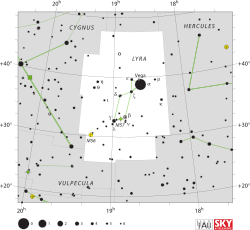Gamma Lyrae

| |
| Observation data Epoch J2000 Equinox J2000 | |
|---|---|
| Constellation | Lyra |
| Right ascension | 18h 58m 56.62241s[1] |
| Declination | +32° 41′ 22.4003″[1] |
| Apparent magnitude (V) | 3.261[2] |
| Characteristics | |
| Spectral type | B9 III[3] |
| U−B color index | –0.125[2] |
| B−V color index | –0.047[2] |
| Astrometry | |
| Radial velocity (Rv) | –21.1[4] km/s |
| Proper motion (μ) | RA: –3.09[1] mas/yr Dec.: +1.11[1] mas/yr |
| Parallax (π) | 5.26 ± 0.27[1] mas |
| Distance | 620 ± 30 ly (190 ± 10 pc) |
| Details | |
| Radius | 15[5] R☉ |
| Surface gravity (log g) | 3.5[6] cgs |
| Temperature | 10,080[6] K |
| Metallicity [Fe/H] | +0.11[6] dex |
| Rotational velocity (v sin i) | 71–72[7] km/s |
| Other designations | |
Gamma Lyrae (γ Lyrae, abbreviated Gamma Lyr, γ Lyr), also named Sulafat,[9] is the second brightest star in the northern constellation of Lyra. With an apparent visual magnitude of 3.3,[2] it is readily visible to the naked eye. Parallax measurements yield an estimated distance of 620 light-years (190 parsecs) from the Sun.
Nomenclature
γ Lyrae (Latinised to Gamma Lyrae) is the star's Bayer designation.
It bore the traditional names Sulafat (Sulaphat), from the Arabic السلحفاة al-sulḥafāt "turtle", and Jugum,[10] from the Latin iugum "yoke". The connection with turtles is that fine harps were traditionally made of tortoiseshell. In 2016, the International Astronomical Union organized a Working Group on Star Names (WGSN)[11] to catalogue and standardize proper names for stars. The WGSN approved the name Sulafat for this star on 21 August 2016 and it is now so entered in the IAU Catalog of Star Names.[9]
In China, 漸台 (Jiāntāi), meaning Clepsydra Terrace, refers to an asterism consisting of this star, Delta2 Lyrae, Beta Lyrae and Iota Lyrae.[12] Consequently, Gamma Lyrae itself is known as 漸台三 (Jiāntāisān, English: the Third Star of Clepsydra Terrace.)
Properties
This is a giant star with a stellar classification of B9 III,[3] indicating it has exhausted the supply of hydrogen at its core and evolved away from the main sequence. The effective temperature of the outer envelope of this star is 10,080 K,[6] giving it the blue-white hue typical of a B-type star.[13] The interferometry-measured angular diameter of this star is 0.74 ± 0.10 mas,[14] which, at its estimated distance, equates to a physical radius of roughly 15 times the radius of the Sun.[5]
In 1909, Canadian astronomer Samuel A. Mitchell identified this star as a spectroscopic binary, although he was unable to split the absorption lines of the components. He found that a period of 25.6 days matched his measurements.[15] It was reported as a spectroscopic binary as recently as 2001,[16] but is now believed to be a single star[17][18] with a high rate of rotation for stars of this type.[16]
References
- 1 2 3 4 5 van Leeuwen, F. (November 2007), "Validation of the new Hipparcos reduction", Astronomy and Astrophysics, 474 (2): 653–664, arXiv:0708.1752
 , Bibcode:2007A&A...474..653V, doi:10.1051/0004-6361:20078357
, Bibcode:2007A&A...474..653V, doi:10.1051/0004-6361:20078357 - 1 2 3 4 Oja, T., "UBV photometry of stars whose positions are accurately known. III", Astronomy and Astrophysics Supplement Series, 65 (2): 405–4
- 1 2 Cowley, A.; et al. (April 1969), "A study of the bright A stars. I. A catalogue of spectral classifications", Astronomical Journal, 74: 375–406, Bibcode:1969AJ.....74..375C, doi:10.1086/110819
- ↑ Evans, D. S. (June 20–24, 1966), "The Revision of the General Catalogue of Radial Velocities", in Batten, Alan Henry; Heard, John Frederick, Determination of Radial Velocities and their Applications, Proceedings from IAU Symposium no. 30, University of Toronto: International Astronomical Union, Bibcode:1967IAUS...30...57E
- 1 2 Lang, Kenneth R. (2006), Astrophysical formulae, Astronomy and astrophysics library, 1 (3rd ed.), Birkhäuser, ISBN 3-540-29692-1. The radius (R*) is given by:
- 1 2 3 4 Balachandran, S.; et al. (April 1986), "The chemical composition of algol systems. III - Beta Lyrae-nucleosynthesis revealed", Monthly Notices of the Royal Astronomical Society, 219: 479–494, Bibcode:1986MNRAS.219..479B, doi:10.1093/mnras/219.3.479
- ↑ Royer, F.; et al. (October 2002), "Rotational velocities of A-type stars in the northern hemisphere. II. Measurement of v sin i", Astronomy and Astrophysics, 393: 897–911, arXiv:astro-ph/0205255
 , Bibcode:2002A&A...393..897R, doi:10.1051/0004-6361:20020943
, Bibcode:2002A&A...393..897R, doi:10.1051/0004-6361:20020943 - ↑ "SULAFAT -- Star in double system", SIMBAD, Centre de Données astronomiques de Strasbourg, retrieved 2012-01-12
- 1 2 "IAU Catalog of Star Names". Retrieved 28 July 2016.
- ↑ Allen, Richard Hinckley (1899), Star-names and their meanings, G. E. Stechert, p. 287
- ↑ IAU Working Group on Star Names (WGSN), International Astronomical Union, retrieved 22 May 2016.
- ↑ (Chinese) AEEA (Activities of Exhibition and Education in Astronomy) 天文教育資訊網 2006 年 7 月 3 日
- ↑ "The Colour of Stars", Australia Telescope, Outreach and Education, Commonwealth Scientific and Industrial Research Organisation, December 21, 2004, retrieved 2012-01-16
- ↑ Richichi, A.; Percheron, I.; Khristoforova, M. (February 2005), "CHARM2: An updated Catalog of High Angular Resolution Measurements", Astronomy and Astrophysics, 431: 773–777, Bibcode:2005A&A...431..773R, doi:10.1051/0004-6361:20042039
- ↑ Mitchell, S. A. (October 1909), "Seven spectroscopic binaries", Astrophysical Journal, 30: 239–242, Bibcode:1909ApJ....30..239M, doi:10.1086/141699
- 1 2 Adelman, Saul J.; et al. (June 2001), "Elemental abundance analyses with DAO spectrograms. XXV. The superficially normal B and A stars alpha Draconis, tau Herculis, gamma Lyrae, and HR 7926", Astronomy and Astrophysics, 371: 1078–1083, Bibcode:2001A&A...371.1078A, doi:10.1051/0004-6361:20010408
- ↑ Roberts, Lewis C., Jr.; Turner, Nils H.; ten Brummelaar, Theo A. (February 2007), "Adaptive Optics Photometry and Astrometry of Binary Stars. II. A Multiplicity Survey of B Stars", The Astronomical Journal, 133 (2): 545–552, Bibcode:2007AJ....133..545R, doi:10.1086/510335
- ↑ Eggleton, P. P.; Tokovinin, A. A. (September 2008), "A catalogue of multiplicity among bright stellar systems", Monthly Notices of the Royal Astronomical Society, 389 (2): 869–879, arXiv:0806.2878
 , Bibcode:2008MNRAS.389..869E, doi:10.1111/j.1365-2966.2008.13596.x
, Bibcode:2008MNRAS.389..869E, doi:10.1111/j.1365-2966.2008.13596.x
External links
- Kaler, James B., "SULAFAT (Gamma Lyrae)", Stars, University of Illinois, retrieved 2012-01-12